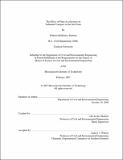| dc.contributor.advisor | Ole Secher Madsen. | en_US |
| dc.contributor.author | Durham, William McKinney | en_US |
| dc.contributor.other | Massachusetts Institute of Technology. Dept. of Civil and Environmental Engineering. | en_US |
| dc.date.accessioned | 2007-08-29T19:04:50Z | |
| dc.date.available | 2007-08-29T19:04:50Z | |
| dc.date.copyright | 2006 | en_US |
| dc.date.issued | 2007 | en_US |
| dc.identifier.uri | http://hdl.handle.net/1721.1/38512 | |
| dc.description | Thesis (S.M.)--Massachusetts Institute of Technology, Dept. of Civil and Environmental Engineering, February 2007. | en_US |
| dc.description | This electronic version was submitted by the student author. The certified thesis is available in the Institute Archives and Special Collections. | en_US |
| dc.description | Includes bibliographical references (p. 181-184). | en_US |
| dc.description.abstract | The surf zone is defined by highly non-linear, breaking waves that have very different acceleration signatures beneath their respective crests and troughs. The consequences of this dissimilarity on sediment transport is not fully understood. This thesis develops methodologies to predict sediment transport under these asymmetric, skewed waves. Two different transport mechanisms are considered: bedload transport and "subsurface" transport. The potential for subsurface transport was first realized by Madsen (1974) who found that the large pressure gradient beneath a breaking wave was sufficient to drive a substantial porous-media flow, adequate to create a soil-mechanics type failure extending several centimeters into a sandy sediment bed. The theoretical model of Madsen (1974) is extended to obtain estimates of subsurface transport by subdividing the sediment in failure into distinct, kinematically admissible slip circles. An equation governing the rotation of each slip circle is developed, yielding the subsurface sediment's horizontal movement as a function of depth. By integration, subsurface transport can predicted. In addition, a method is developed for estimating bedload transport under breaking waves, accounting for the enhanced shear stress beneath the wave's crest. An existing bedload formula is used as the foundation for this predictive model. | en_US |
| dc.description.abstract | (cont.) The validity of the two predictive models is substantiated by experiments conducted in a laboratory wave flume. Breaking waves are passed over lightweight, plastic beads representive of uncohesive sediment. The surficial and subsurface transport is experimentally measured. Using velocity records from the laboratory waves, the theoretical models are used to make predictions of each type of transport. Both models produce good agreement with experimental observations. Finally, laboratory wave data from Madsen (1974) are scaled to the the size of waves typical of the surf zone. Using parameters characteristic of sand, the two models predict a subsurface transport of the same order as bedload transport for typical wave and sediment parameters. Furthermore, subsurface transport is found to be proportional to the characteristic length scale of the wave squared, while bedload transport is proportional to the length scale to the power of 1.5. | en_US |
| dc.description.statementofresponsibility | by William McKinney Durham. | en_US |
| dc.format.extent | 184 p. | en_US |
| dc.language.iso | eng | en_US |
| dc.publisher | Massachusetts Institute of Technology | en_US |
| dc.rights | M.I.T. theses are protected by copyright. They may be viewed from this source for any purpose, but reproduction or distribution in any format is prohibited without written permission. See provided URL for inquiries about permission. | en_US |
| dc.rights.uri | http://dspace.mit.edu/handle/1721.1/7582 | |
| dc.subject | Civil and Environmental Engineering. | en_US |
| dc.title | The effect of fluid acceleration on sediment transport in the surf zone | en_US |
| dc.type | Thesis | en_US |
| dc.description.degree | S.M. | en_US |
| dc.contributor.department | Massachusetts Institute of Technology. Department of Civil and Environmental Engineering | |
| dc.identifier.oclc | 156305711 | en_US |

